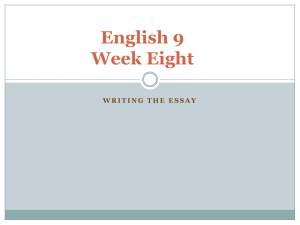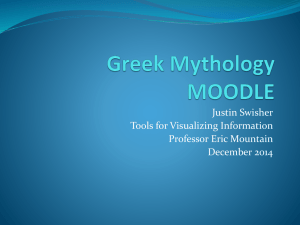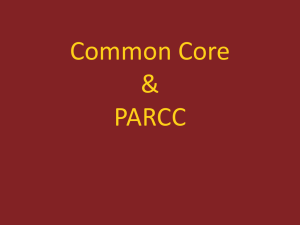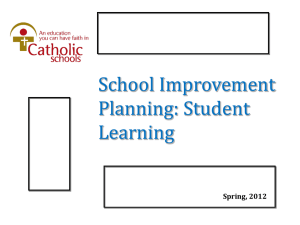Using The Snake Fence
advertisement
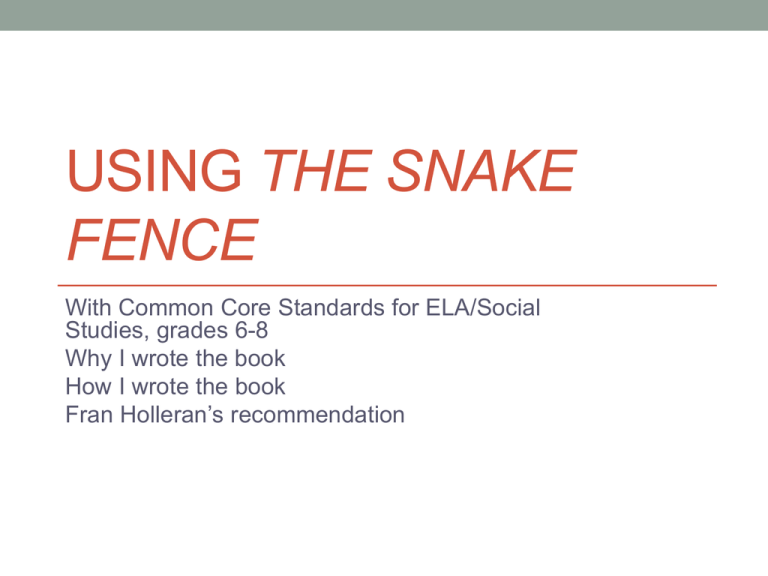
USING THE SNAKE FENCE With Common Core Standards for ELA/Social Studies, grades 6-8 Why I wrote the book How I wrote the book Fran Holleran’s recommendation Interdisciplinary Cooperation between Social Studies and Literature Because the social studies standards are coupled with English language arts, both departments benefit from cooperation. Creative teachers sharing ideas generate more interesting lesson plans. Students gain sense of subject matter’s relevance when information is reinforced in more than one discipline. Students read one book instead of two, thus cutting down on time spent on homework. • Book Summary for The Snake Fence, done by Rose Milner, 7th grader at Booker Middle School • Noble Butler, a 16-year-old Quaker boy from Pennsylvania, on a journey to find himself, makes some friends on the way. Noble meets lovely Molly, a rambunctious young woman whom he finds amazing and falls in love. Peter, a quiet boy, joins the militia and stays at Fort Cumberland with Molly. Broken Blade is a 15-year-old Indian who has a grudge and a debt. John McCowen is a wounded man who has his eyes on Noble’s sister. • • The fascination. . . Wood work is a skill Noble longs to have, but he can’t afford the tools. • • Peter and Molly get married and are expecting a baby in the spring. Noble is shocked. He hates the idea of Peter and Molly. He loved her more than anything and is jealous. • • Israel Pemberton is a wealthy Quaker who offers Noble a runner job. Noble accepts. What is a runner? To deliver messages? It pays. It’ll get him tools. • • Remember the Walking Purchase? Walkers ran, and cheated the Indians out of their land. • • During the Peaceful Compromise, the Pennsylvania government and the Quakers talk to the Indians to make peace. Indians and Quakers travel to Easton to have discussions and make peace. Noble stores peace offerings with Peter and Molly and meets baby Sarah. The conference failed. In the end the compromise didn’t go as planned. • • Noble found his worth. The courage he showed was brought forth, and Noble realized his hopes of finding himself were true. The amazing Noble Butler is content with life. CCSS.ELA-Literacy.RH.6-8.1 Cite specific textual evidence to support analysis of primary and secondary sources. Braddock’s defeat, p.120 ff. There are many descriptions of this battle, in journals written at the time, other newspaper articles, letters home to England, even George Washington’s memoirs written much later. Google “General Braddock’s defeat” for secondary sources of information and compare them with The Pennsylvania Gazette article. CCSS.ELA-Literacy.RH.6-8.2 Determine the central ideas or information of a primary or secondary source; provide an accurate summary of the source distinct from prior knowledge or opinions. Minutes of the dinners at Pembertons’: p.175-6, 182-186 The description of these dinner conversations was taken from the minutes written at the dinners, although not all of the minutes were used in the story. These minutes are part of the Special Collections Library of Haverford College. Have students read the account here and tell or write what they have learned from this primary source. The two quotations from The Pennsylvania Gazette, found on pages 4 and 121-122, could also be used here. See also the discussion questions on this chapter, p. 227. CCSS.ELA-Literacy.RH.6-8.3 Identify key steps in a text’s description of a process related to history/social studies (e.g., how a bill becomes law, how interest rates are raised or lowered). Primary source materials for this section come from Minutes of the Provincial Council. Choose another negotiating topic, such as found in President Jimmy Carter’s book, The Blood of Abraham, about peace negotiations between Palestine, Israel, and several other countries in the 1970’s and analyze them. Have students assume roles of diplomats from each country and have a mock peace conference of their own, to see if they can achieve peace in the Middle East, using the background information in Carter’s book. Alternatively, let students pick a topic relevant to their own lives and set up a series of negotiations based on Noble’s description of how these things work. In To Kill a Mockingbird, students might re-enact the scene of Tom Robinson’s trial or write about the appeal of his sentence as if it had occurred, thus learning the roles of various officers of a court and the appeals process. • Craft and Structure • CCSS.ELA-Literacy.RH.6-8.4 Determine the meaning of words and phrases as they are used in a text, including vocabulary specific to domains related to history/social studies. • • Look up the definition of “traitor.” Does this apply to Israel Pemberton, Jr.? Was he charged with treason? Look up information on his biography. Would you consider him a successful man? Why or why not? What traitors have been convicted in the United States? If time allows, you might have the class conduct a trial of Israel Pemberton. In Red Badge of Courage, students could look up the organization of an army: battalion, regiment, etc., and the line of command. Has this changed since the Civil War? • CCSS.ELA-Literacy.RH.6-8.5 Describe how a text presents information (e.g., sequentially, comparatively, causally). • • The author presents a great deal of information about the Walking Purchase in a narrative, causal way. Have students write or tell the information in a comparative way by finding other sources of this information, either on-line or in print sources, and comparing them to this account. Are students convinced that the circumstances of The Walking Purchase were the cause of Indian violence on the frontier? Could there have been other causes? What might they be? Then analyze the effectiveness of conveying history in each form. • CCSS.ELA-Literacy.RH.6-8.6 Identify aspects of a text that reveal an author’s point of view or purpose (e.g., loaded language, inclusion or avoidance of particular facts) • • Describe the differences between the Butler family’s response and John’s response. Why did they react so differently? What do you think is the author’s point of view here? In To Kill a Mockingbird, which characters do you think reveal the author’s point of view? Which are in contrast to it? Find examples of loaded language. • CCSS.ELA-Literacy.RH.6-8.7 Integrate visual information (e.g., in charts, graphs, photographs, videos, or maps) with other information in print and digital texts. • Map, p. vi • Compare the 1756 map on p. vi of The Snake Fence with a map of Indian paths found in Indian Paths of Pennsylvania, by Paul Wallace or another source on line. Explain why the same area is portrayed so differently. Research descriptions of travel in colonial times, such as are found in Into the American Woods, by James H. Merrell. Then look again at the map on p. vi of The Snake Fence and compare it with maps of 1856, 1956, and 2006. If you don’t live in Pennsylvania, do the same kind of research for your own state as well. 1756 Map of Pennsylvania In Red Badge of Courage, the site of the battle is not named, but the author says in a later publication that it was the Battle of Chancellorsville. Find on-line maps of that three-day battle and try to locate Henry Fleming’s part in the story. • CCSS.ELA-Literacy.RH.6-8.8 Distinguish among fact, opinion, and reasoned judgment in a text. • Stories in the Rain,” p. 45-46 • In this passage we learn that Daniel’s and Christopher’s attitudes toward Indians differ. Can you distinguish among fact, opinion, and reasoned judgment in this scene? What are they based on? Can Noble tell the difference? At this point are his thoughts and feelings based on fact, opinion, or reasoned judgment? Do they change by the end of the book? Choose another topic about which people feel strongly. Can you identify and distinguish between fact, opinion, and reasoned judgment? In To Kill a Mockingbird there are countless examples to be analyzed. Pick any character and focus on that person’s speech. Which dominates: fact, opinion, or reasoned judgment? What does that tell you about that character? How does that person advance the story? Does that person reflect the author’s point of view? • In Red Badge of Courage, the soldiers have difficulty distinguishing between fact and opinion and question the officers’ reasoned judgment about the battle. Find several examples where soldiers fail to distinguish between fact and opinion. Then find passages where they question the officers’ reasoned judgments. What impact do these scenes have on the main character? Henry Fleming tries to understand his own character, whether he is cowardly or brave. By the end of the story, is Henry Fleming relying more on fact, opinion, or reasoned judgment about his own actions? CCSS.ELA-Literacy.RH.6-8.9 Analyze the relationship between a primary and secondary source on the same topic. See Standard 6-8.1 above. • Range of Reading and Level of Text Complexity • CCSS.ELA-Literacy.RH.6-8.10 By the end of grade 8, read and comprehend history/social studies texts in the grades 6–8 text complexity band independently and proficiently. • Other title suggestions for interdisciplinary projects: • • Colonial Period: The Scarlet Letter, by Nathaniel Hawthorne, The Crucible, by Arthur Miller • • Creating a New Nation: “The Midnight Ride of Paul Revere,” by Longfellow, The poetry of Phyllis Wheatley, Johnny Tremain, by Esther Forbes • • The Early Republic: Eclipse: A Novel about Lewis and Clark, by Richard Wheeler; Undaunted Courage, by Stephen Ambrose;Native American myths • America Grows and Changes: Moby Dick, by Herman Melville; “Civil Disobedience,” by Henry David Thoreau; Harriet Tubman: Conductor on the Underground Railway, by Ann Petry The Nation Divided: Red Badge of Courage, by Stephen Crane; “Drummer Boy of Shiloh,” by Ray Bradbury; “O Captain, My Captain,” by Walt Whitman; Across Five Aprils, by Irene Hunt; John Brown’s Body by Stephen Vincent Benet Modern America: The Holocaust: The Diary of Anne Frank; by Anne Frank; The Devil’s Arithmetic, by Jane Yolan; Night, by Elie Weisel For more Twentieth Century suggestions, ask any English teacher. For more writing topic suggestions, google “Writing Across the Disciplines” for a very long list of resources. The one from Brevard County, FL, is an excellent one. • How Booker Middle School’s Visual and Performing Arts department used The Snake Fence:

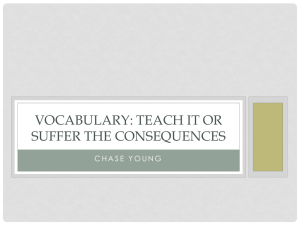
![iPads_and_Writing_2013[1]](http://s2.studylib.net/store/data/005383991_1-1bc8c0f2382c2ccb89e094c534f531f0-300x300.png)
